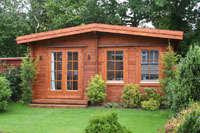At work, in the garden...
No more traffic jams or leaves on the line; install a garden office and your commute could be a scented stroll beside the flowerbeds.

Over the past 20 years advances in communications technology have enabled more and more of us to work from home. Depending on the size of your house and the depth of your pocket, a spare bedroom, a loft conversion or an extension are all now viable office spaces. The big drawback is that domestic life and commercial life can overlap to the detriment of each other.
Clatter from children, your partner, or friends dropping by can interfere with business and break your concentration. Then again, out-of-hours phone-calls and the niggling urge to check e-mails mean you're never quite off-duty, so quality time suffers too. Hence the rise of the outdoor home office.
What nicer way to differentiate between "home" and "office both physically and psychologically, than to walk down the garden path. George Bernard Shaw, Dylan Thomas, Roald Dahl and Philip Pullman produced great work in such diverse garden buildings a gypsy caravan and a railway carriage. How about you?
 A purpose-built garden office is quicker and cheaper to build than either a loft conversion an extension and can be up and running immediately and with minimum disruption, most are assembled onsite in a few days. A purpose-built garden office is quicker and cheaper to build than either a loft conversion an extension and can be up and running immediately and with minimum disruption, most are assembled onsite in a few days.
Position - Respect your neighbour's sightlines when choosing where to put your building, and consider not only the view from your own home, but also the outlook from your office. Don't just plonk the office wherever your old shed was or have it staring right back at the house. If space permits, why not take a sideways look? Choose some distant focal point like a large tree or a spire as the view from your desk to exercise your eyes after straining at the computer, and use liberal planting to screen the office from the house so you can really turn off at night.
Style - Choose a building that's in character with its surroundings. It shouldn't stick out like a sore thumb, but neither does it have to be bland. Different makers have quite distinctive styles, so you can buy into the appropriate look without going bespoke. Look out for special features that are tailored to your needs, as well as French doors and windows that flood it with light.
Interior - The size and the internal specifications will depend upon your budget and the kind of work you do, but there are a few key points. An office that's suitable for all-year working should have insulated walls, floor and roof. You'll need electric radiators or convector heaters, not only for warmth, but to keep paperwork and equipment dry as a bone. The windows, doors and locks should be of household quality, anything short of British Standards could hinder contents insurance. Check when ordering that the doors and windows that come as standard can be configured to suit the orientation of your building. Can you add more windows for extra light?
Before the big day you will need an electrician to run an armoured cable from your household fuse-box, and unless you opt for wireless based technology you will also need direct telephone links. Lay them at the same time, and allow some surplus capacity for upgrades.
Base - The site itself should be firm and level. A poured concrete footing is the ideal, but sand and paving slabs will be fine in many cases. Don't place your office directly on the ground: you could get an awful sinking feeling, be troubled by damp or be undermined by burrowing foxes. Preparatory ground-works are usually your responsibility, so remember to budget for them separately.
Planners: - A Guide for Householders is a helpful government leaflet available free from local planning authorities or online at: https://www.odpm.gov.uk/
Do you need permission?
If you submit a sketch showing the details and dimensions of the proposed building, and it's position in relation to your house, your local authority should be able to advise within 14 days whether planning permission is required. It shouldn't be necessary if;
- Your office is a temporary demountable structure, built in sections without foundations.
- It stands no higher than 4m (13ft) in the case of a rigid roof.
- It doesn't stand between your home and the highway.
|